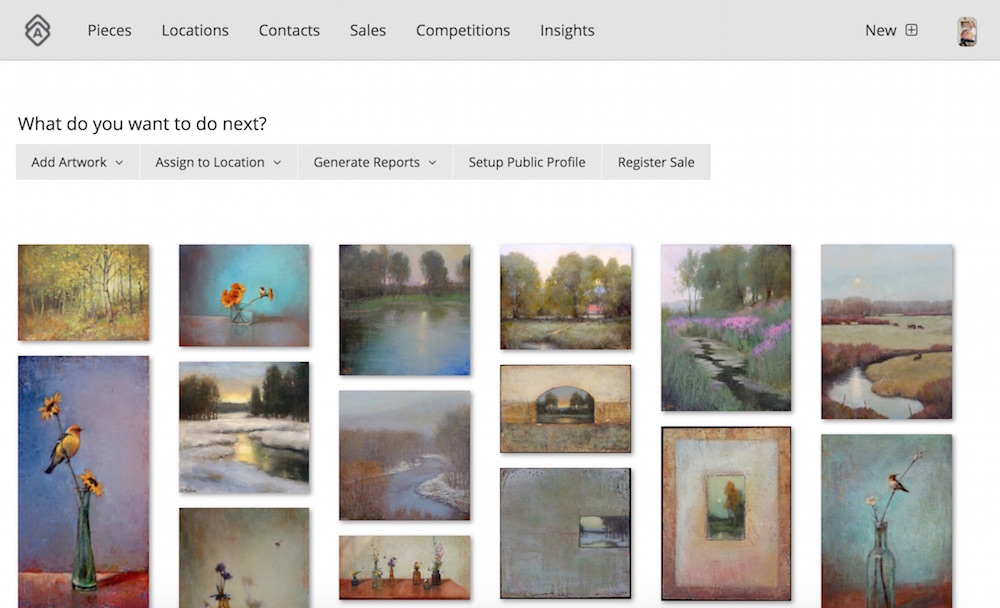Documenting art isn’t something that usually comes to mind when you are busy creating in your studio. But, it’s so important for artists to catalog their work!
Has it been years since you’ve written down the story of a piece? Well then, it might be time to set aside some time to remember as many details as you can.
I’ve been an artist for many years and I wish someone had told me to catalog everything better. I wish a good inventory management system had existed. I don’t know where a lot of my painting are and who owns them.
Documenting art has benefits ranging from increasing the value of your pieces to preserving your history. And, the earlier you start, the better it will be.
Here are some important points to think about when it comes to inventorying your artwork:
Increasing Value for Collectors
Typically, many artists don’t think about documenting the history of their art. We like to think a work speaks for itself. But, savvy collectors are advised to learn as much about a piece as they can before purchasing.
So, imagine the benefits of being able to tell an art collector a piece’s history, awards, exhibitions, and publications. Provenance goes a long way towards enhancing the value of your work.
Fine art appraiser Christine Guernsey explains, Solid and documentable provenance increases the value and desirability of an artwork, in an article for Chubb Insurance. Christine also notes, Failure to keep careful records of this pertinent information can cause a work to be undervalued [or] remain unsold.
Collectors will enjoy the extra information and personal touch. And, they will have a reason to buy your artwork over others’.
Helping Out Art Dealers and Museums
When an artwork comes with a story, it’s much more attractive to art dealers and curators. Eric Rhoads, publisher of PleinAir Magazine, recently did a fascinating podcast with curator and Executive Director of the Irvine Museum, Jean Stern.
They discuss the importance of provenance and Jean stresses, Do what you can now to make an art historian’s life easier in the future and you’ll be rewarded. Eric explains how he writes down the details of every plein air study he creates including the story of where he was, the date, and who he painted with. He even suggests writing down the exact GPS location!
While this information might not seem too important at the moment, it could mean a lot 50 years down the road. And, even now it will be helpful to art dealers and curators who are interested in creating exhibitions of your work. The easier you can make their lives, the more likely they are to want to feature you and your artwork.
Preserving Your Story
I don’t know who owns many of my earlier paintings or where they are. I can’t look back and see my evolution as an artist, and that’s such a loss. When you archive your work you are making sure that your artist’s story doesn’t disappear.
It’s also so easy to forget when or where you painted a specific piece, your inspirations, and the techniques you might have tested out. When you have a system in place it becomes a simple part of your workflow. You just need to fill in the main details, write a description, and add in some notes. Then, that memory and part of your history is saved.
Set aside some time to also add in any competitions, awards won, gallery showings, museum exhibitions, publication features, and who bought the piece along with their contact details into your inventory management system.
All this will make planning your retrospective a lot simpler. You will know where everything is, so you can call up the right collectors to borrow work. When you are starting out this might be a far off thought. But, when you do get to that point in your career you’ll be so glad you documented your art along with its details and stories!
How to Document Your Art
The thought of cataloging when you already have a full to-do list can seem stressful. But, just like with other winning entrepreneurs, we must have good working habits to be successful artists. The good news is that the more you practice a new task, the more it will become a habit.
Not sure how to begin? Remember you know your pieces better than anyone. Build a story for each piece that is engaging and specific— and work backwards. What can you share with your buyer that is interesting and unique to each piece of art?
You’ll also be amazed at how easy it is to document art once you know the way to do it. You will be on ‘a roll’ in no time. Art inventory software is a great way to track your artwork and it’s more user-friendly than ever.
I’ve written about Artwork Archive before and it is still my favorite inventory software. The intuitive program is so beautiful to look at, and easy to use. With a little effort, you can build a living archive of your work and enjoy all the benefits it brings. I only wish Artwork Archive was around when I first started my professional art career.
I hope this helps those of you wondering if and how you should catalog your artwork. And the best part, you can start documenting art and preserving your story today with 20% off Artwork Archive for life.
~Lori 🙂








Hu ah, Lori! I love my Artwork Archive and they have some great new upgrades in the works. I can’t wait!
Happy to hear that Heather!
Thanks for the feedback! 🙂
I can tell you as a long time art consultant that information about art is just as important as the art itself. All artists and all collectors should keep detailed records.
I agree! 🙂